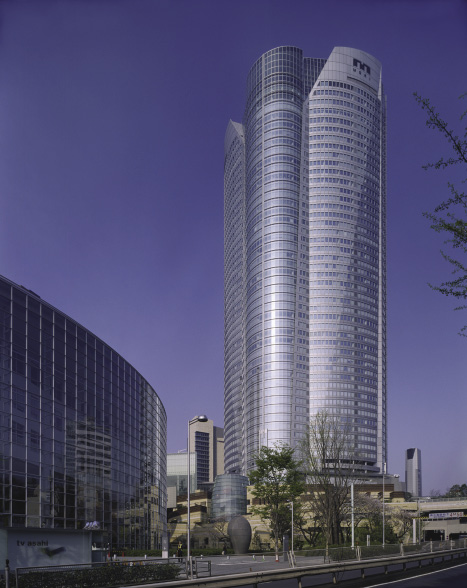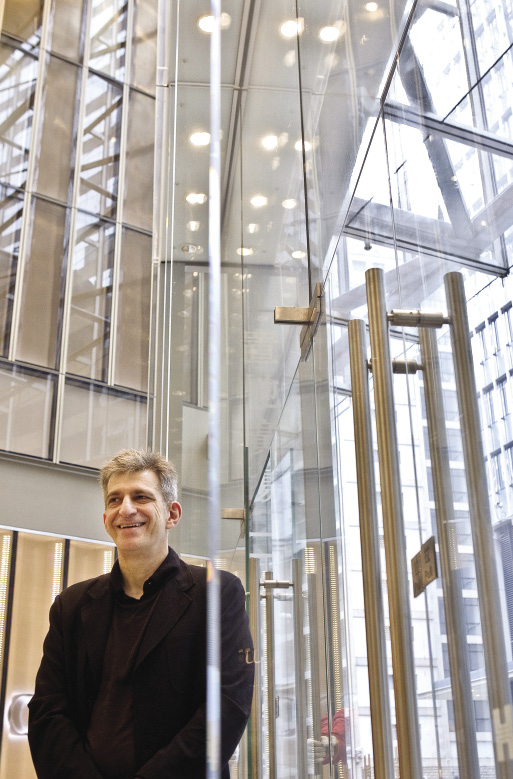Editors’ Note
Paul Katz focuses on the planning, design, and development of office, mixed-use, and high rise buildings. He has senior responsibilities in all aspects of commercial architecture, including business development, management, and design. He established KPF’s strong presence in Japan and Hong Kong, and has been instrumental in setting up the firm’s China operations in Shanghai. He has degrees in architecture from the Technion in Israel and Princeton University.
Will you tell us about the internal philosophy at KPF?
We aspire to provide the highest level of quality in design and service, which we believe comes from a foundation of teamwork and education. Our goal is to provide the best possible work environment, which offers opportunities for growth, learning, and involvement throughout the design process. For example, we structure teams so that architects of all levels are able to participate, providing opportunities for learning and contribution one might not experience in a typical studio environment. This approach has produced a unique and compelling office culture that has enabled us to successfully grow over the years.
In 2010, when many firms continued to lay off employees, KPF grew to a staff size larger than our pre-recession number. This growth was particularly significant because much of it took place in our U.S. office, which was noted in Crain’s as the #1 firm in New York City. KPF adheres to the model of having a central office, with 16 of our 20 principals and 350 of our 550 staff members in New York City. We believe this concentration allows for greater interaction between peers and teams, cross-pollination of ideas, and consolidation of expertise for the benefit of our clients. But it also means that when we grow, regardless of the location of our projects, we hire locally, benefiting the economy of our city.
How does the KPF philosophy relate to your work?
Increasing density at city centers is more effective in preserving land resources and reducing energy usage than the alternative of urban sprawl. We see this in the U.S., Europe, and across Asia. In Asia in particular, there is an escalating need for sustainable solutions as a result of rapid migration into cities.
We see the tall building as a social and sustainable paradigm, in which individual buildings form part of a larger ecosystem of vertical centers linked by horizontal networks of public transportation, rather than as objects in isolation. KPF has been on the forefront of this movement, providing design for some of the most progressive and complex projects from entirely new sustainable cities to super-tall towers. With the density of such designs, public transport is encouraged, land is conserved, and energy and water uses reduced.
The phenomenon of super-tall buildings appears to be dominating new developments across the world. How will this affect the overall look of cities in the future?
We also believe in incorporating multiple uses into a single tall tower, creating a “vertical city” – rather than a horizontal city – and relying on elevators instead of cars; this is all part of our sustainable agenda. Combining uses also allows for economy of scale in terms of resource usage: one structure is more effective than multiple structures as energy usage is shared so distribution is easier, and spaces and systems are multifunctional.
As this paradigm continues to be embraced as a programmatic, cultural, and sustainable solution for the world’s growing cities, KPF continues to push the envelope in terms of functionality and technology. All told, the firm has designed – some completed, some under construction – the tallest buildings in London, Paris, Tokyo, Seoul, Shanghai, Hong Kong, and many other cities in China. One of these towers, in Shenzhen, when completed, will be the tallest building in China and the tallest office building in the world.
The proliferation of the super-tall tower has had a dramatic effect on its cities’ skylines in the developing world and also in cities such as London. Other cities are playing host to similarly profound changes, which are only now beginning to take shape.

Roppongi Hills in Tokyo – the largest
private-sector urban redevelopment
project in Japan’s history
How strong is KPF’s business in the United States?
We’re staying busy at home as well, working on projects in New York, Boston, D.C., Philadelphia, Chicago, Dallas, Miami, Seattle, Minneapolis, San Francisco, Los Angeles, Tucson, and Las Vegas, as well as Toronto and Vancouver in Canada. In recent years, we have been commissioned for a lot of academic work, such as Michigan’s Ross School of Business and the University of Minnesota’s Science Teaching and Student Services Building, and we’re now working on the Advanced Science Research Center for the City University of New York.
Currently, we’re master planning the Hudson Yards for Related Companies and Oxford Properties Group. At 12 million square feet, it is the largest undeveloped single piece of property in Manhattan. Starting at the north end of the High Line, KPF’s master plan will offer a flexible mix of office, residential, retail, hotel, and public space. Lifestyle is driven by the changing times and the traditional zoning distinctions among work, living, and leisure and entertainment no longer apply. With this in mind, the mix of uses within Hudson Yards has been carefully calibrated to create a unique destination where people will work, shop, live, and visit.
How will you ensure that the growth continues?
Most important to future growth is our unique office culture. By maintaining this culture and the quality of our staff, growth is organic. Additionally, one of the best measures is the appreciation of our clients, the majority of whom are repeat clients. In a challenging world economy in which developers and financiers have become increasingly conservative and cost-conscious, our clients have continued to employ us for their design needs because they have the confidence that we will provide them with world-class design excellence matched with consistent service.•



